Disconnect the heater hoses and then remove the water temperature control assembly (A).

Use fender covers to avoid damaging painted surfaces.
To avoid damaging the cylinder head, wait until the engine coolant temperature drops below normal temperature before removing it.
When handling a metal gasket, take care not to fold the gasket or damage the contact surface of the gasket.
To avoid damage, unplug the wiring connectors carefully while holding the connector portion.
Mark all wiring and hoses to avoid misconnection.
Turn the crankshaft pulley so that the No. 1 piston is at top dead center.
Remove the intake manifold and exhaust manifolds. (Refer to Intake and exhaust system in this group)
Remove the timing chain. (Refer to Timing system in this group)
Disconnect the heater hoses and then remove the water temperature control assembly (A).

Remove the LH/RH exhaust camshaft OCV (A).
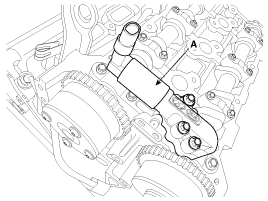

Remove the LH/RH camshaft bearing cap (A) and thrust bearing cap (B).
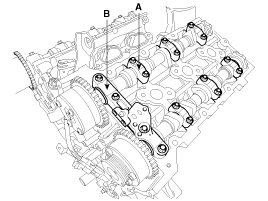

Remove the LH/ RH camshaft assembly(A).
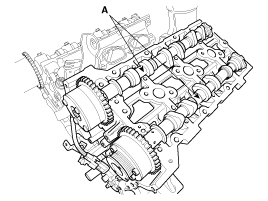

Remove the cylinder head bolts, then remove the LH/ RH cylinder heads.
Uniformly loosen and remove the 16 cylinder head bolts, in several passes, in the sequence shown. Remove the 16 cylinder head bolts and plate washers.
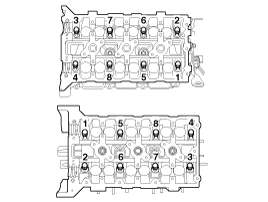
Head warpage or cracking could result from removing bolts in an incorrect order.
Lift the cylinder head from the dowels on the cylinder block and place the cylinder head on wooden blocks on a bench.
Be careful not to damage the contact surfaces of the cylinder head and cylinder block.
Identify MLA, valves and valve springs as they are removed so that each item can be reinstalled in its original position.
Remove the MLAs(A).
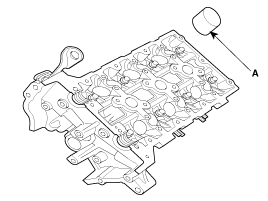
Remove the valves.
Using SST(09222-3K000, 09222-3C300), compress the valve spring and remove retainer lock.

Remove the spring retainer.
Remove the valve spring.
Remove the valve.
Remove the valve stem seal.
Do not reuse old valve stem seals.
Remove the intake camshaft OCV (A).

Inspect for flatness.
Using a precision straight edge and feeler gauge, measure the surface contacting cylinder block and the manifolds for warpage.
Flatness of cylinder head gasket surface
Standard : Less than 0.05mm(0.002in.)[Less than 0.02mm(0.0008in.)/150x150]
Flatness of manifold gasket surface
Standard : Less than 0.1mm(0.0039in.)[Less than 0.03mm(0.001in.)/110x110]
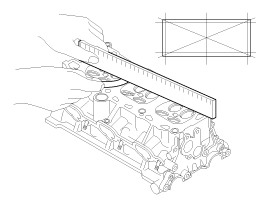
Inspect for cracks.
Check the combustion chamber, intake ports, exhaust ports and cylinder block surface for cracks. If cracked, replace the cylinder head.
Inspect valve stems and valve guides.
Using a caliper gauge, measure the inside diameter of the valve guide.
Valve guide I.D.
Intake / Exhaust : 5.500 ~ 5.512mm (0.216 ~ 0.217in.)
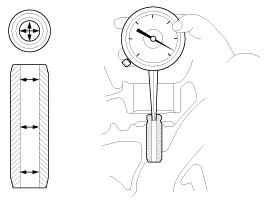
Using a micrometer, measure the diameter of the valve stem.
Valve stem O.D.
Intake : 5.465 ~ 5.480mm (0.2151 ~ 0.2157in.)
Exhaust : 5.458 ~ 5.470mm (0.2149 ~ 0.2153in.)

Subtract the valve stem diameter measurement from the valve guide inside diameter measurement.
Valve stem-to-guide clearance
[Standard]
Intake : 0.020 ~ 0.047mm (0.0008 ~ 0.0018in.)
Exhaust : 0.030 ~ 0.054mm (0.0012 ~ 0.0021in.)
[Limit]
Intake : 0.07mm (0.0027in.)
Exhaust : 0.09mm (0.0035in.)
Inspect valves.
Check the valve is ground to the correct valve face angle.
Check that the surface of the valve for wear.
If the valve face is worn, replace the valve.
Check the valve head margin thickness.
If the margin thickness is less than minimum, replace the valve.
Margin
[Standard]
Intake : 1.56 ~ 1.86mm(0.06142 ~ 0.07323in.)
Exhaust : 1.73 ~ 2.03mm(0.06811 ~ 0.07992in.)

Check the valve length.
Length
Intake : 105.27mm (4.1445in)
Exhaust : 105.50mm (4.1535in)
Check the surface of the valve stem tip for wear.
If the valve stem tip is worn, replace the valve.
Inspect valve seats
Check the valve seat for evidence of overheating and improper contact with the valve face.
If the valve seat is worn, replace cylinder head.
Before reconditioning the seat, check the valve guide for wear. If the valve guide is worn, replace cylinder head. Recondition the valve seat with a valve seat grinder or cutter. The valve seat contact width should be within specifications and centered on the valve face.
Inspect valve springs.
Using a steel square, measure the out-of-square of the valve spring.
Using vernier calipers, measure the free length of the valve spring.
Valve spring
[Standard]
Free height : 43.86mm (1.7267in.)
Out-of-square : 1.5˚
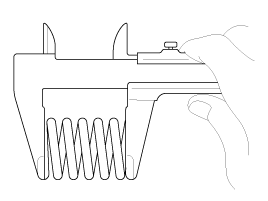
Inspect MLA.
Using a micrometer, measure the MLA outside diameter.
MLA O.D.
Intake/Exhaust :34.964 ~ 34.980mm(1.3765 ~ 1.3771in.)
Using a caliper gauge, measure MLA tappet bore inner diameter of cylinder head.
Tappet bore I.D.
Intake/Exhaust :35.000 ~ 35.025mm(1.3779 ~ 1.3789in.)
Subtract MLA outside diameter measurement from tappet bore inside diameter measurement.
MLA to tappet bore clearance
[Standard]
Intake/Exhaust : 0.020 ~ 0.061mm(0.0008 ~ 0.0024in.)
[Limit]
Intake/Exhaust : 0.07mm(0.0027in.)
Inspect cam lobes.
Using a micrometer, measure the cam lobe height.
Cam height
[Standard value]
Intake
3.3L: 46.3mm(1.8228in.)
3.8L: 46.8mm (1.8425in.)
Exhaust
3.3L/3.8L : 45.8mm (1.8031in.)
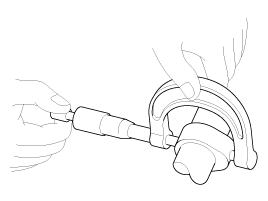
If the cam lobe height is less than standard, replace the camshaft.
Inspect camshaft journal clearance.
Clean the bearing caps and camshaft journals.
Place the camshafts on the cylinder head.
Lay a strip of plastigage across each of the camshaft journals.
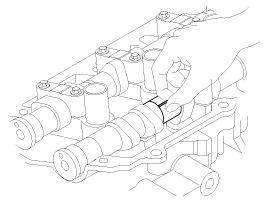
Install the bearing cap (A) and thrust bearing cap (B) with specified torque. (Refer to Cylinder head in this group)
Tightening torque
1st step : 5.8N.m (0.6kgf.m, 4.3lb-ft)
2nd step : 9.8 ~ 11.8N.m (1.0 ~ 1.2kgf.m, 7.2 ~ 8.7lb-ft)
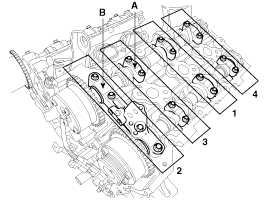
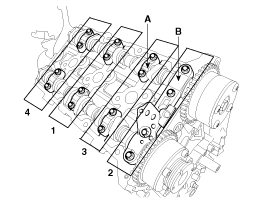
Do not turn the camshaft.
Remove the bearing caps.
Measure the plastigage at its widest point.
Bearing oil clearance
[Standard value]
Intake
No.1 journal :0.027 ~ 0.057mm (0.0011 ~ 0.0022in.)
No.2,3,4 journal : 0.030 ~ 0.067mm (0.0012 ~ 0.0026in.)
Exhaust
No.1 journal : 0.027 ~ 0.057mm (0.0011 ~ 0.0022in.)
No.2,3,4 journal : 0.030 ~ 0.067mm (0.0012 ~ 0.0026in.)
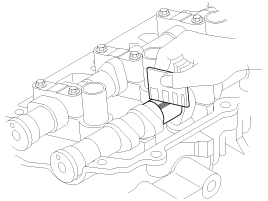
If the oil clearance is greater than maximum, replace the camshaft. If necessary, replace cylinder head.
Completely remove the plastigage.
Remove the camshafts.
Inspect camshaft end play.
Install the camshafts.
Install the bearing cap (A) and thrust bearing cap (B) with specified torque. (Refer to Cylinder head in this group)
Tightening torque
1st step : 5.8N.m (0.6kgf.m, 4.3lb-ft)
2nd step : 9.8 ~ 11.8N.m (1.0 ~ 1.2kgf.m, 7.2 ~ 8.7lb-ft)


Using a dial indicator, measure the end play while moving the camshaft back and forth.
Camshaft end play
[Standard value] : 0.02 ~ 0.18mm(0.0008 ~ 0.0071in.)
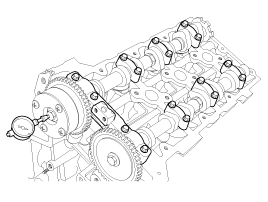
If the end play is greater than maximum, replace the camshaft. If necessary, replace cylinder head.
Remove the camshafts.
Inspect CVVT assembly.
Check that the CVVT assembly will not turn.
Apply vinyl tape to the retard hole except the one indicated by the arrow in the illustration.
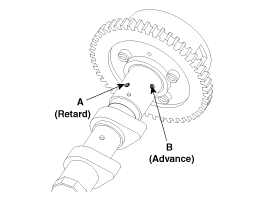
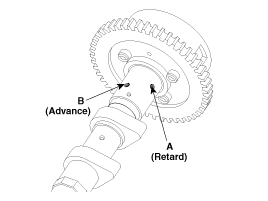
Wind tape around the tip of the air gun and apply air of approx. 150kpa(1.5kgf/cm², 21psi) to the port of the camshaft.
(Perform this in order to release the lock pin for the maximum delay angle locking.)
When the oil splashes, wipe it off with a shop rag.
Under the condition of (3), turn the CVVT assembly to the advance angle side (the arrow marked direction in the illustration) with your hand.
Depending on the air pressure, the CVVT assembly will turn to the advance side without applying force by hand. Also, under the condition that the pressure can be hardly applied because of the air leakage from the port, there may be the case that the lock pin could be hardly released.

Except the position where the lock pin meets at the maximum delay angle, let the CVVT assembly turn back and forth and check the movable range and that there is no disturbance.
Standard: Movable smoothly in the range about 22.5°
Turn the CVVT assembly with your hand and lock it at the maximum delay angle position (counter clockwise).
Thoroughly clean all parts to be assembled.
Before installing the parts, apply fresh engine oil to all sliding and rotating surfaces.
Replace oil seals with new ones.
Install valves.
Using SST(09222-3C100), push in a new oil seal.
Do not reuse old valve stem seals.
Incorrect installation of the seal could result in oil leakage past the valve guides.
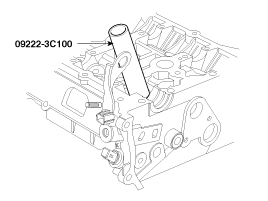
Install the valve, valve spring and spring retainer.
Place valve springs so that the side coated with enamel faces toward the valve spring retainer and then install the retainer.
Using the SST (09222 - 3K000, 09222-3C300), compress the spring and install the retainer locks. After installing the valves, ensure that the retainer locks are correctly in place before releasing the valve spring compressor.
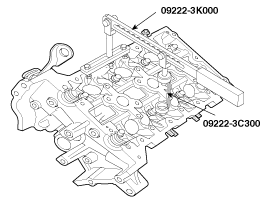
Lightly tap the end of each valve stem two or three times with the wooden handle of a hammer to ensure proper seating of the valve and retainer lock.
Install the MLAs.
Check that the MLA rotates smoothly by hand.

MLA can be reinstalled in its original position.
Install the intake camshaft OCV(A).
Tightening torque
9.8 ~ 11.8Nm(1.0 ~ 1.2kgf.m, 7.2 ~ 8.7lb-ft)

To install OCV with gray colored connector into RH bank.
To install OCV with black colored connector into LH bank.
Do not reuse the OCV when dropped.
Keep clean the OCV.
Do not hold the OCV sleeve during servicing.
When the OCV is installed on the engine, do not move the engine while holding the OCV yoke.
Thoroughly clean all parts to be assembled.
Always use a new head and manifold gasket.
The cylinder head gasket is a metal gasket. Take care not to bend it.
Rotate the crankshaft, set the No.1 piston at TDC.
Install the cylinder heads.
The sealant locations on cylinder head and cylinder block must be free of engine oil and ETC.
Apply sealant on cylinder block top face before assembling cylinder head gaskets.
The part must be assembled within 5 minutes after sealant was applied.
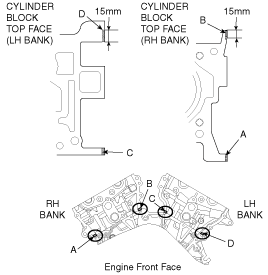
Refer to below illustration to apply the sealant.
Bead width : 2.0~3.0 mm
Sealant locations : 1.0~1.5mm from block surface
Recommended sealant : Liquid sealant TB1217H
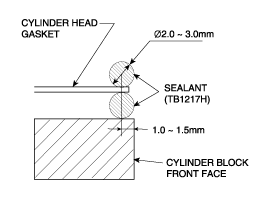
Apply sealant on cylinder head gaskets after assembling cylinder head gaskets on cylinder block.
The part must be assembled within 5 minutes after sealant was applied.
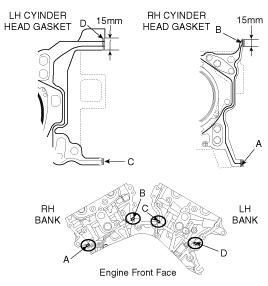
Be careful of the installation direction.
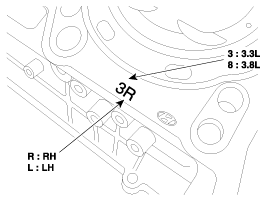
Install the cylinder head.
Remove the extruded sealant after assembling cylinder heads.

Place the cylinder head carefully in order not to damage the gasket with the bottom part of the end.
Install the cylinder head bolts.
Do not apply engine oil on the threads and under the heads of the cylinder head bolts.
Using SST(09221-4A000), install and tighten the cylinder head bolts and plate washers, in several passes, in the sequence shown.
Tightening torque
Head bolt : 37.3~41.2Nm (3.8~4.2kgf.m, 27.5~30.4lb-ft) + 118~122° + 88~92°
Bolt (A) : 18.62 ~ 23.52Nm(1.9 ~ 2.4kgf.m, 13.74 ~ 17.36lb-ft)
Always use new cylinder head bolts.
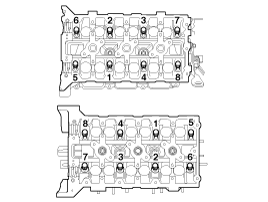
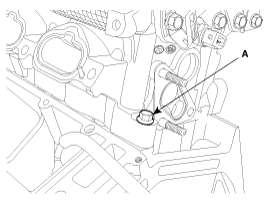
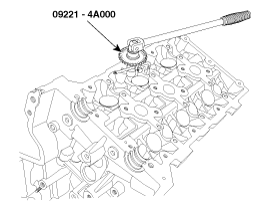
Install the CVVT and camshaft sprocket.
Tightening torque
64.7 ~ 76.4Nm(6.6 ~ 7.8 kgf.m, 47.7 ~ 56.4lb-ft)
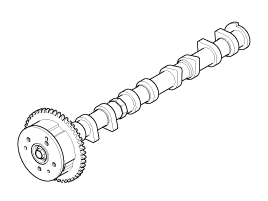
Install camshaft-inlet to dowel pin of CVVT assembly.
At this time, do not install to oil hole of camshaft-inlet.
Hold the hexagonal head wrench portion of the camshaft with a vise, and install the bolt and CVVT assembly.
Do not rotate CVVT assembly when camshaft is installed to dowel pin of CVVT assembly.
Install the camshafts(A).
Apply a light coat of engine oil on camshaft journals.
Assemble the key groove of camshaft rear side to the same level of head top surface.
Be careful the right, left bank, intake, exhaust side before assembling.


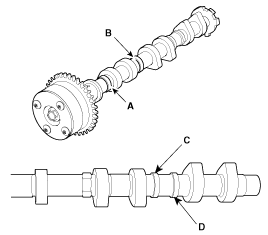
As for camshaft identification, refer to the table below.
Displacement | Outer diameter | |
LH | RH | |
3.3L Intake camshaft | A : 27mm (1.0630in.) B : 30mm (1.1811in.) C : 27mm (1.0630in.) D : 27mm (1.0630in.) | A : 27mm (1.0630in.) B : 30mm (1.1811in.) C : 30mm (1.1811in.) D : 30mm (1.1811in.) |
3.8L Intake camshaft | A : 27mm (1.0630in.) B : 30mm (1.1811in.) C : 30mm (1.1811in.) D : 27mm (1.0630in.) | A : 27mm (1.0630in.) B : 30mm (1.1811in.) C : 27mm (1.0630in.) D : 30mm(1.1811in.) |
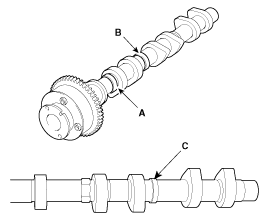
As for camshaft identification, refer to the table below.
Displacement | Outer diameter | |
LH | RH | |
3.3L / 3.8L Exhaust camshaft | A : 27mm (1.0630in.) B : 30mm (1.1811in.) C : 27mm (1.0630in.) | A : 27mm (1.0630in.) B : 30mm (1.1811in.) C : 30mm (1.1811in.) |
Install the LH/RH camshaft bearing cap (A) and thrust bearing cap (B).
Tightening torque
1st step : 5.8N.m (0.6kgf.m, 4.3lb-ft)
2nd step : 9.8 ~ 11.8N.m (1.0 ~ 1.2kgf.m, 7.2 ~ 8.7lb-ft)


Be sure to install the thrust bearing cap bolts and the bearing cap bolts in the correct place.
Be careful the right, left bank, intake, exhaust side, front mark before assembling.
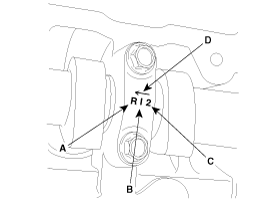
A : L(LH),R(RH)
B : I(Intake),None(Exhaust)
C : Journal number
D : Front mark
Rotate the crankshaft so as not to contact the valves to the pistons by positianing the pistons below 10mm(0.3937in.) from the top of cylinder block.
Install the LH/RH exhaust camshaft OCV (A).
Tightening torque
9.8 ~ 11.8N.m (1.0 ~ 1.2kgf.m, 7.2 ~ 8.7lb-ft)


Install the timing chain. (Refer to Timing system in this group)
Install the cylinder head cover. (Refer to cylinder head assembly in this group)
Install the intake manifold and exhaust manifolds. (Refer to Intake and exhaust system in this group)
Install the water temperature control assembly (A) and then connect the oil cooler hoses.
Tightening torque
19.6 ~ 23.5Nm (2.0 ~ 2.4kgf.m, 14.5 ~ 17.4lb-ft)

Refill engine oil.
Clean the battery posts and cable terminals with sandpaper. Assemble and then apply grease to prevent corrosion.
Inspect for fuel leakage.
After assembling the fuel line, turn on the ignition switch (do not operate the starter) so that the fuel pump runs for approximately two seconds and fuel line pressurizes.
Repeat this operation two or three times, then check for fuel leakage at any point in the fuel lines.
Refill radiator and reservoir tank with engine coolant.
Bleed air from the cooling system.
Start engine and let it run until it warms up. (Until the radiator fan operates 3 or 4 times.)
Turn Off the engine and let it cool down. Check the level in the radiator, add coolant if needed. This will allow trapped air to be removed from the cooling system.
Put radiator cap on tightly, then run the engine again and check for leaks.